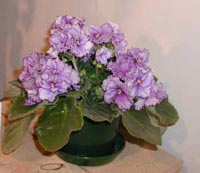Resource Library
Plant of the Week: Violet, African
The University of Arkansas System Division of Agriculture does not promote, support or recommend plants featured in "Plant of the Week." Please consult your local Extension office for plants suitable for your region.
Plant of the Week
African Violet
Latin: Saintpaulia ionanth

The African violet (Saintpaulia ionantha) is a member of the tropical Gesneriad family and is related to such plants as gloxinia and streptocarpus. Although the most common color is blue, selections are available in shades of pink, rose, red, purple, violet, white and even yellow. Plants grow in a rosette while young but eventually the stem may elongate to 6 inches or more in length. The fleshy, hairy leaves are to 6 inches long and have the ability to produce plantlets from the leaves, the most common means of propagation.
The African violet was discovered in 1892 by Baron Walter Von Saint Paul about an hour from Tanga on the modern day border of Tanzania and Kenya. The baron, realizing the plant was different, sent specimens to his father in Germany who in turn shared the find with a botanist at Royal Botanic Garden in Hanover. This botanist, Herman Wendland, realized the plant was new to science and named the genus after the Saint Paul family and coined the species name "ionantha" which in Latin means "violet like."
The commercialization of this new crop began almost immediately. The rights to distribute the plant were sold to the German seed company, Ernst Benary, in 1893. This company provided seeds to W.K. Harris, of the Harris Seed Company in Philadelphia, in 1894.
Although grown locally in the United States, the real discovery of African violets by the American public began after 1927 when the Armacost and Royston Nursery in Los Angeles released a number of hybrids including ‘Blue Boy’ and ‘Sailor Boy.’ In the first chain-store venture in plant selling, Woolworth & Co. distributed these new hybrids and spread them throughout the country, making African violet nationwide.
African violets are easy to grow if all of the rules are followed. First, they must have a highly organic potting soil and this potting mix must be kept uniformly moist. To accomplish this task, many growers use various wick watering systems. Plants must be fertilized regularly when making active growth with any balanced houseplant fertilizer or one of the special African violet fertilizers on the market. Being tropical, African violets should never be exposed to temperatures below 55 degrees.
The most exacting requirement for African violet culture is light. These plants are "photo accumulators ," meaning that they require a given quantity of light energy before they will flower. But because they are under story plants, they must never have full sun.
Ideally, plants should have between 500- to 600-foot candles of light, which is about the amount of light received on a north window sill in the summer. In the winter, that amount of light is about what is available in an east window.
Some gardeners choose to use artificial light and place fluorescent lights 12 inches above the violets. If the light is managed correctly and the plants have fertilizer during periods of active growth, it's possible to produce three flushes of blooms a year from the plants.
By: Gerald Klingaman, retired
Extension Horticulturist - Ornamentals
Extension News - November 7, 2003
The University of Arkansas System Division of Agriculture does not maintain lists of retail outlets where these plants can be purchased. Please check your local nursery or other retail outlets to ask about the availability of these plants for your growing area.